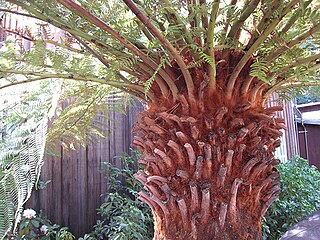
Acanthomintha duttonii is a species of annual plant endemic to San Mateo County, California in the Lamiaceae family. It is commonly called San Mateo thornmint or Dutton's acanthomintha and is found growing on serpentine soils near the Crystal Springs Reservoir in a six-mile (10 km) long strip on the east side of Montara Mountain at elevations of approximately 150 to 300 meters.

Cordylanthus tenuis is a species of flowering plant in the broomrape family known by the common name slender bird's beak. It is native to the US states of California, Oregon, and Nevada, where it grows in woodland and forest. It erects a spindly stem which may exceed a meter in height with sparse narrow leaves a few centimeters long, and is sometimes sticky with glandular secretions. The plant is greenish and tinted with yellow or purple coloration. The stem branches at intervals and at the end of each branch is a cluster of one to several flowers. Each pocket-shaped flower is one to two centimeters long and about one wide, made up of fuzzy maroon lobes with white or yellow lips.

Gentiana setigera is a species of gentian known by the common name Mendocino gentian. It is native to southern Oregon and northern California where it grows in wet places in the California Coast Ranges. It grows in serpentine soils.

Hastingsia serpentinicola is a species of flowering plant known by the common name Klamath rushlily. It is native to the mountains of northwestern California and southwestern Oregon, where it grows in serpentine soils. This is a perennial herb growing from a black bulb 2 to 4 centimeters long and producing an erect stem up to 50 centimeters tall. A number of long, bending leaves surround the stem at its base, and the rest of the stem is naked. The top portion of the erect stem is a narrow, pointed inflorescence of many white or greenish lilylike flowers. Each small flower has six curled perianth parts and six protruding stamens with very large anthers. The flowers fall away to leave the developing fruits, which are capsules a few millimeters wide containing black seeds.
Helianthus bolanderi is a species of sunflower known by the common names Bolander's sunflower and serpentine sunflower. It is native to California and Oregon, where it grows mainly in mountainous areas, often in serpentine soils. It has been found from southwestern Oregon as well as in northern and central California as far south as Santa Cruz County, with reports of a few isolated populations in southern California.
Horkelia sericata is a species of flowering plant in the rose family known by the common names silky horkelia and Howell's horkelia. It is native to the Klamath Mountains of northern California and southern Oregon, where it grows in the chaparral and forest, often on serpentine soils. This is a perennial herb growing in small tufts of erect leaves and stems. The leaves are 3 to 15 centimeters long and are each made up of herringbonelike rows of small, tightly packed leaflets. The green leaflets bear long, silky white hairs, giving the plant a silvery green look. The green, brown, or reddish stems reach up to 50 centimeters long and bear loose inflorescences of many flowers. The flower has small green sepals covered in luxuriant white hairs, and white or pink-tinted petals with two-lobed tips.
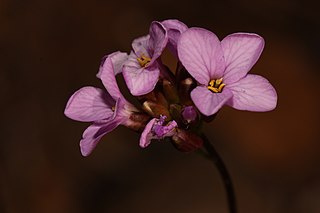
Arabis aculeolata is a species of flowering plant in the mustard family known by the common name Waldo rockcress. It is native to a small range in the mountains of southern Oregon, where it is an uncommon member of the serpentine soils flora. Reports of its occurrence in Del Norte County, California are unconfirmed. This is a perennial herb growing from a tough caudex covered in large hairs and the bases of leaves shed in previous seasons. It produces one or more erect stems to heights between 20 and 35 centimeters. The stems are dark in color, often reddish or purplish, and are coated in stiff white hairs. The leaves form a basal rosette about the caudex. They are oval-shaped, green in color and sparsely covered in coarse white hairs, up to 4 centimeters long, and with smooth or wavy edges. Leaves located farther up the stem are smaller. The flowers have dark purple sepals and lighter purple petals. The fruit is a long, thin, erect silique up to 6.5 centimeters long.
Arnica cernua is a species of arnica known by the common name serpentine arnica. It is native to the Klamath Mountains of northern California and southern Oregon, where it is a member of the serpentine soils flora.
Campanula angustiflora is a species of bellflower known by the common name Eastwood's bellflower. It is endemic to California, where it grows in the serpentine soils of the hills and mountains surrounding the San Francisco Bay Area. It is a flower of the chaparral plant community. This is a hairy annual herb producing a thin, branching stem up to 20 centimeters tall. The leaves are leathery in texture and oval in shape, measuring between 0.5 and 1 centimeter in length, with a few teeth along the edges. The bell-shaped flower is pale blue or white and just a few millimeters long. The fruit is a ribbed, spherical capsule.
Boechera constancei is a species of flowering plant in the mustard family known by the common name Constance's rockcress. It is endemic to California, where it is known only from the northern Sierra Nevada of Plumas and Sierra Counties. It is a member of the serpentine soils flora. This is a perennial herb growing from a branching, woody caudex. It produces one or more erect, hairless stems to maximum heights between 15 and 30 centimeters. The caudex is surrounded by a dense basal rosette of stiff, blue-green, lance-shaped leaves up to 3 centimeters long. There may be a few smaller leaves along the stem. The inflorescence produces 5 to 10 white mustardlike flowers with protruding stamens. The fruit is a hanging green silique 4 or 5 centimeters long which contains round, winged seeds.
Lessingia arachnoidea is a rare species of flowering plant in the daisy family known by the common name Crystal Springs lessingia. It is endemic to California, where it is known from a few occurrences in the vicinity of Crystal Springs Reservoir on the San Francisco Peninsula. It may also exist in Sonoma County to the north. The plant grows in chaparral, scrub, and other local plant communities, often on serpentine soils. This is an annual herb producing a slender, erect stem up to 80 centimeters in maximum height. It is woolly toward the ends of the stems, less so toward the base of the plant. The leaves are narrow and sometimes toothed, the lowest approaching 11 centimeters long and the uppermost reduced in size. The inflorescence is made up of a single flower head at the tip of the slender stem. The flower head is lined with tiny lance-shaped phyllaries with purplish pointed tips and sometimes a coat of woolly fibers. The head is discoid, lacking ray florets but bearing several funnel-shaped lavender disc florets with raylike lobes. The fruit is an achene with a very hairy hard body 2 or 3 millimeters long and a small, bristly pappus on top.

Lewisia oppositifolia is a rare species of flowering plant in the Montiaceae family known by the common name opposite-leaf lewisia. It is native to the Klamath Mountains of Josephine County, Oregon, and Del Norte County, California, where it is a local serpentine endemic generally found in moist areas. This is a perennial herb growing from a small taproot and caudex unit. It produces a basal rosette of several lance-shaped, blunt-tipped fleshy leaves up to 11 centimeters long. There are sometimes smaller leaves located on the lower stem. The inflorescence is made up of one or more erect stems up to about 20 centimeters long, each bearing 1 to 6 flowers. The flower has 8 to 11 white to pale pink petals with blunt or jagged tips, each between 1 and 2 centimeters long. At the center are several stamens with pale anthers. This plant has a limited distribution and it is threatened by human activity in the area, such as logging.
Sedum oblanceolatum is a species of flowering plant in the stonecrop family known by the common names oblongleaf stonecrop and Applegate stonecrop. It is native to the Klamath Mountains of southwestern Oregon and far northern California, where it grows on many types of rocky substrate, such as serpentine soils and other ultramafics. It is a succulent plant forming basal rosettes of waxy leaves. The leaves are widely lance-shaped, widest near the distal end and narrowing to rounded or notched tips. Smaller leaves occur farther up the stem. The small inflorescence grows a few centimeters tall and bears up to 50 flowers in a flat-topped array. The flowers have cream or yellowish petals up to a centimeter long.
Sedum radiatum is a species of flowering plant in the stonecrop family known by the common name Coast Range stonecrop. It is native to Oregon and California, where it is known from several coastal and inland mountain ranges, including the Klamath Mountains and the Sierra Nevada. It grows in many types of rocky habitat, sometimes on serpentine soils. It is an annual or biennial succulent plant producing several stems with elevated, somewhat basal rosettes of leaves. The leaves are not much more than a centimeter long. They are green or yellowish with green, purple or red veining. The inflorescence is a short, erect array of many densely packed flowers. The flowers have yellow, cream, or white petals which are lance-shaped and one half to 1 centimeter long.
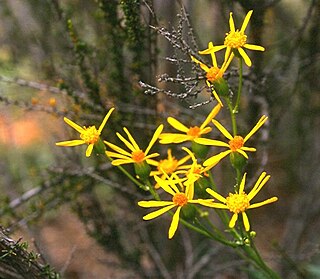
Packera layneae, known by the common name Layne's ragwort and Layne's butterweed, is a rare species of flowering plant in the aster family.

Silene campanulata is a species of flowering plant in the pink family known by the common names Red Mountain catchfly and bell catchfly.
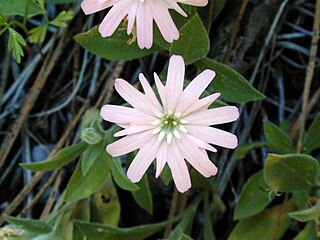
Silene hookeri is a species of flowering plant in the pink family known by the common names Hooker's silene, Hooker's catchfly, Hooker's Indian pink, and Hooker's glandular campion.
Thelypodium brachycarpum is a species of flowering plant in the mustard family known by the common names shortpod thelypody and short-podded thelypodium. It is native to parts of northern California and southern Oregon, where it grows in several types of habitat, including alkaline wetlands and serpentine soils.
Cranichis ricartii is a rare species of orchid known by the common name Puerto Rico helmet orchid. It is native to Puerto Rico, where it is known from three locations in one forest. The plant has also been seen in Guadeloupe. The plant's rarity is the main reason for its listing as an endangered species of the United States.
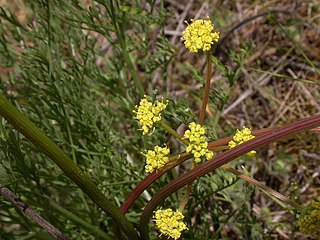
Lomatium cookii is a rare species of flowering plant in the carrot family known by the common names Cook's lomatium and agate desertparsley. It is endemic to Oregon in the United States, where it grows in only two valleys. It is a federally listed endangered species.




